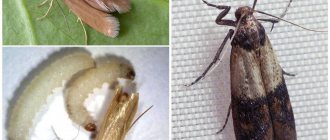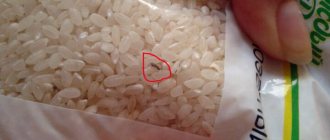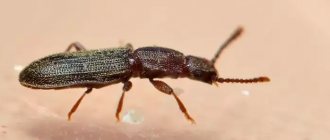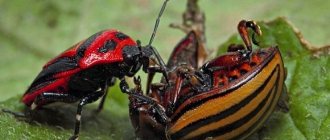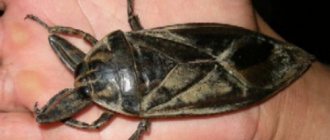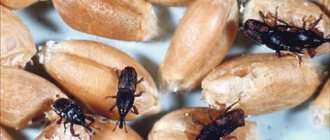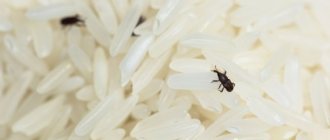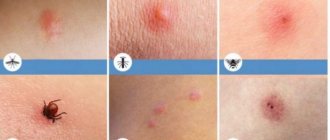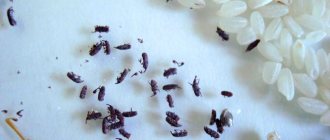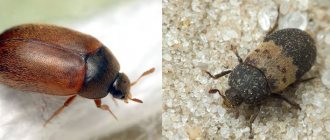Every good housewife, who carefully monitors the order in her own kitchen, is sure that she is insured against the appearance of any living creatures on her territory, and even more so in her products. However, parasites can appear in any kitchen. Therefore, every housewife should know the types of insects that can settle in cereals and methods of combating them.
Types of insects in cereals and their characteristics
There are only a few varieties of parasites that can appear in cereals by eating supplies. This:
- Red flour eater.
- Suriname mucoed.
- Small flour beetle.
- Large flour beetle.
- Indian food moth.
- Mill fire.
- Bread grinder.
- Weevil.
Mucoed
The red mucous beetle is a bug measuring about 2.5 mm , can reach 4 mm, and is flat in appearance. Color: red or light brown. This parasite can fly. The pest usually lives where it is warm and high humidity - in rotten flour or soaked grain in elevators and granaries, in flour mills, cereal factories, and bakeries. This pest is not interested in dry grain with a moisture content of up to 16%.
Red mukoed
The red flour beetle can get into the kitchen with flour, cereals or grain food for pets - rodents and rabbits. In addition to flour and wet grains, this bug also likes cookies and dried fruits; it can even appear in moldy vegetables.
The mucoed eater lives for 3 years , laying up to 600 eggs . The female produces eggs on the food she eats. A few days later, white larvae in villi with a reddish tip of the abdomen emerge from the eggs. The larvae grow up to 4 mm.
This parasite is dangerous not only by eating cereal reserves. Flour eater infects foods with toxins, which, if they enter the body, cause allergies or disruption of the gastrointestinal tract. In addition, the products in which the mucous has settled are affected by various fungi and bacteria, which can also cause intestinal diseases. The eggs laid by this parasite are so small that they are practically invisible. Eating foods contaminated with mucous eggs is very dangerous.
The Suriname mucoed is a close relative of the red mucoed. They differ only in color. Surinamese - dark brown.
Suriname mucoed
Flour beetle
The small mealworm is a red-brown insect with a glossy surface, 3–4 mm . The beetle doesn't fly. The larvae of the small flour beetle are yellow, 6–7 mm in size, and have a flattened shape. After 5–12 molts, the larva turns into a pupa.
Small mealworm
The large flour beetle has a flat, black-brown body up to 18 mm . Its larvae are brown with a yellow tint, naked, cylindrical in shape, up to 25 mm in length. The insect development cycle lasts 47–56 days at a temperature of about 24 degrees Celsius.
Large flour beetle
The small black beetle is black or dark brown in color with a light belly and paws up to 5.5 mm . Its larvae are light brown in color, flat with hairs, their length reaches 12 mm. Larval development lasts about 1 year.
Mealworms are the larvae of the mealworm. They move easily through thick products. Tolerates temperatures down to 0 degrees Celsius.
Mealworm
Flour beetles of all the listed types can live in the kitchens of private homes, where they often enter in bags with contaminated flour or starch, from where they very quickly spread throughout all clean cereals in the kitchen.
These bugs eat rice, wheat, rye and any other flour. His favorite dishes include semolina, millet and oatmeal. Less commonly found in buckwheat, rice cereal and dried fruits.
The bug spreads very quickly. The female can lay eggs in grocery bags, in any crevice, in cracks in walls, under wallpaper. Thanks to the sticky mucus covering her eggs, they stick to any surface. Each female lays up to 1 thousand eggs in the rump and crevices of cabinets.
food moth
The Indian food moth is gray in color and grows up to 12 mm . It flies quickly and chaotically, especially at night. The food moth lives for 2–3 weeks, managing to lay 400–500 eggs . The reproduction process occurs when the adult insect has access to moisture.
Food moth larvae grow to 14–16 mm ; in appearance they resemble worms with 5 pairs of legs. It is the larvae that spoil food. They eat away the area they are in. The larvae then pupate and within a month turn into a butterfly. After laying eggs, the butterflies die.
The mill moth is distinguished by its two-colored forewings in appearance. The larvae are light yellow in color, 10–15 mm in size. They actively crawl, choosing food to suit their taste. When eating reserves, the larva forms a thin arachnoid tube, covered with excrement on top, in which it lives and feeds.
Food moths grow in flour and cereals. Moth larvae are capable of eating all types of cereals, dried fruits, nuts, chocolate, tea, coffee, and spices.
Bread grinder
The bread grinder has wings and is up to 3 mm in length . This is a light brown bug. Harm to products is caused both by the beetle itself and its larvae. The female lays 20–60 eggs . The larvae are off-white in color and up to 5 mm in size. There are spikes on the back. The upper jaws are well developed. It also pupates in kitchen supplies.
Bread grinder
He ends up in the kitchen with his favorite food - crackers, cookies, dry goods and other hard baked goods, in which passages and excrement will become noticeable over time. In addition to baked goods, grinders eat dry herbs, tea leaves, muesli, chocolates, coffee and even paper. The bread grinder strives for the light. These are the most tenacious, prolific, voracious and unpretentious parasites.
Weevil
The harmful insect is dark brown in color with a characteristic elongated proboscis. Using the jaws of the weevil, it penetrates into the soft part of the grains. This bug lives in rice, buckwheat, flour, pasta and legumes. May also eat flour products, tea, coffee. Capable of producing offspring 5–6 times during the year, laying up to 200 eggs .
Weevil
Weevil larvae are very dangerous. In appearance they look like worms up to 4 mm in size. The larvae penetrate the grain and gnaw it completely. The weevil is capable of falling into suspended animation under unfavorable living conditions and remaining there for several months, maintaining its vital functions.
How to keep worms in winter
You can’t get worms in winter - all fishermen know this, so you should take care of feeding in the summer. To do this, just before the frost (they are different in different regions, so everyone should adapt to their own climate) dig up worms and put them aside. At the same moment you will need to build a wooden box. You need to understand that it should include about 20 kg of earth. Having dealt with this, you can go collect fallen leaves, with which you will need to cover a third of the box. Everything else is covered with soil. Next, they place the worms in a box and sprinkle them with soil.
Important! There should not be too many worms in the box, otherwise they will soon no longer fit in the box.
Next, you need to wrap the container with a damp cloth and send it to some cool place. It can be anything: a garage, a balcony, an attic, etc. The most important thing is to maintain positive temperatures. Earthworms for fishing should be fed once a day.
When going fishing, you can put the bait along with the ground in a special mitten. To prevent the bait from freezing, it is better to hide it under outer clothing and take it out as needed.
You can’t get worms in winter - all fishermen know this, so you should take care of feeding in the summer. To do this, just before the frost (they are different in different regions, so everyone should adapt to their own climate) dig up worms and put them aside. At the same moment you will need to build a wooden box. You need to understand that it should include about 20 kg of earth. Having dealt with this, you can go collect fallen leaves, with which you will need to cover a third of the box. Everything else is covered with soil. Next, they place the worms in a box and sprinkle them with soil.
Health hazards from eating contaminated foods
When bugs or worms are found in cereals and other products, the question naturally arises: can they be eaten? The answer is negative. It is better to get rid of such products. There are several reasons:
- There is a danger of poisoning or intoxication of the body, especially when products are damaged by mucous due to mold getting into the products.
- There is a high probability of allergic reactions to parasite waste. The most dangerous are pests of flour and semolina due to the difficulty of distinguishing their excrement from the products themselves. Exacerbation of asthma is also possible.
- Low nutritional value of products, since beetles extract all the beneficial substances from them.
Caring for the environment
Agronutris and Jiminis don't just want to make money. Their representatives are confident that popularizing insect products can save the environment. The fact is that raising livestock produces a lot of carbon dioxide. And this, in turn, leads to an increase in air temperature and aggravates the problem of global warming. And there are far fewer emissions when making mealworm products. In addition, these products obviously will not be expensive.
The production of meat and many other products harms the environment
But it will take time to accustom people to such unusual food. But when crunchy insects become available for sale, people's squeamishness should disappear over time. And it’s time to get rid of it, because the EFSA agency is already ready to recognize the safety of crickets and the larvae of several other species of beetles.
If you are interested in science and technology news, subscribe to our Telegram channel. There you will find announcements of the latest news from our site!
Perhaps in the future the way we think about food will change a lot. Recently, scientists have proposed stopping eating fish and replacing it with jellyfish. Why they put forward such an unusual proposal can be read in this material.
Signs of parasites in the kitchen
Timely detection of the appearance of pests of cereals, flour and other dry shelf-stable products in the kitchen will help the housewife save most of the supplies and maintain the budget. If the following appeared in the kitchen:
- Cobwebs on the surface of flour or semolina.
- Small holes in beans, nougat, peas.
- Excrement in dried fruits.
- Worms in cereals, noticed during washing, as well as cocoons of larvae.
- Cereal grains glued together.
then you should immediately take measures to combat uninvited guests in the kitchen.
Rules
To preserve the taste of cereals as much as possible, you must adhere to the rules presented below.
- Be sure to pour purchased bulk products into special food containers.
- The storage location should be dry and dark, with good ventilation.
- Optimal storage conditions are temperature from –5 to +5 °C and humidity 60–70%. Make sure that the maximum temperature does not exceed +18 °C.
- Do not keep strong-smelling foods (smoked meats, spices, etc.) near cereals.
Optimal flour storage conditions
How to properly store yeast?
Methods for cleaning stainless steel spoons and forks
Methods for killing insects in products
Methods for getting rid of parasites in food products in the kitchen depend on the type of pests and the products themselves. As for flour, the answer is clear: the flour should be thrown away . The likelihood of toxic and allergenic pest excrement getting into the product is too high.
If parasites have infected the cereal, it should be washed in water . Beetles and their larvae are lighter than water, so they will float to the surface. Legumes should be soaked in salt water for some time. Then the water is drained and the products are dried. Before washing, it is advisable to sift the cereal through a sieve with medium holes in order to get rid of grains of pest excrement.
Pests of cereals and flour in the kitchen do not tolerate extreme temperatures . Therefore, it is enough to place bags of cereals in the freezer overnight or heat the cereals in the oven at a temperature of 110 degrees Celsius , distributing them on a baking sheet.
Borax-based bait can be used as a chemical pest control product. Semolina, powdered sugar and borax or boric acid are mixed in equal proportions into the dough and rolled into balls, which are laid out in kitchen cabinets. The recipe is especially effective against flour beetle.
Important! Under no circumstances should you use chemicals to control pests. You can get poisoned by toxins!
Regardless of the chosen method of combating the pests themselves, it is necessary to treat the furniture and dishes where the pests lay eggs. The treatment is carried out with a vinegar solution.
How to feed "house" worms
Simply creating conditions where worms can be stored well is not enough. It is necessary to take care of their nutrition, otherwise they will die. Such specimens can recycle almost anything. Some people may not know, but worms love paper, so wet wipes are an ideal option. If you don’t have them on hand, peels from various vegetables or finely chopped seeds, as well as coffee and tea leaves will do.
Important! In cases where it is necessary for the worms to be stored longer, shells or chalk should be added twice a month. Without an oxidizing agent, the “fish delicacy” will not live long.
Don’t forget to add water once a week, which can serve as a soil moisturizer. Humidity should be at least 70%. It is very simple to determine: taking a little soil in your palm and trying to squeeze water out of it, one drop should appear. This is an ideal indicator that everything is fine with moisture.
Vinegar solution
Each housewife has her own recipes that she uses if moths appear in cereals. How to get rid (reviews emphasize that this method works flawlessly) from insects if the soap solution did not cope with its task? Housewives agree that this is only the first stage of processing. To be completely sure of effectiveness, after the shelves have dried, you need to wipe them with a cloth moistened with 5% or 9% vinegar. Now you can count on your cabinets being completely free of larvae and eggs.
Store funds
It is strictly not recommended to use chemical products sold in stores to combat food moths. They can provoke poisoning of the human body. Cereals and other bulk products extremely quickly absorb toxic substances that are part of insecticides, as a result of which they become unsuitable for consumption.
Effective store products:
- Raid;
- Aeroxon;
- Raptor.
Such preparations are available in the form of aerosols, sticky tapes, and various traps that should be hung in the habitat of kitchen insects.
Traps
In hardware stores, Aeroxon and Raptor traps are available, designed to destroy insect pests. They contain pheromones that attract parasites, as well as a sticky surface on which they remain.
Traps against food moths do not contain toxins or toxic substances. They can be placed in the kitchen, near food. The shelf life of the traps is 3 months.
Bottom line
We agree that worms are not those representatives of the animal world that you want to pet. But these amazing creatures are an interesting object for scientific research. Some species of this huge class of the animal kingdom are useful for human life, and in Australia they even erected a monument to the earthworm.
Another popular game in the world is slither io, in which, while controlling a worm, you need to eat balls without crashing into other worms. There the worms can be very large.
Author of the article: Valery Skiba
Source
